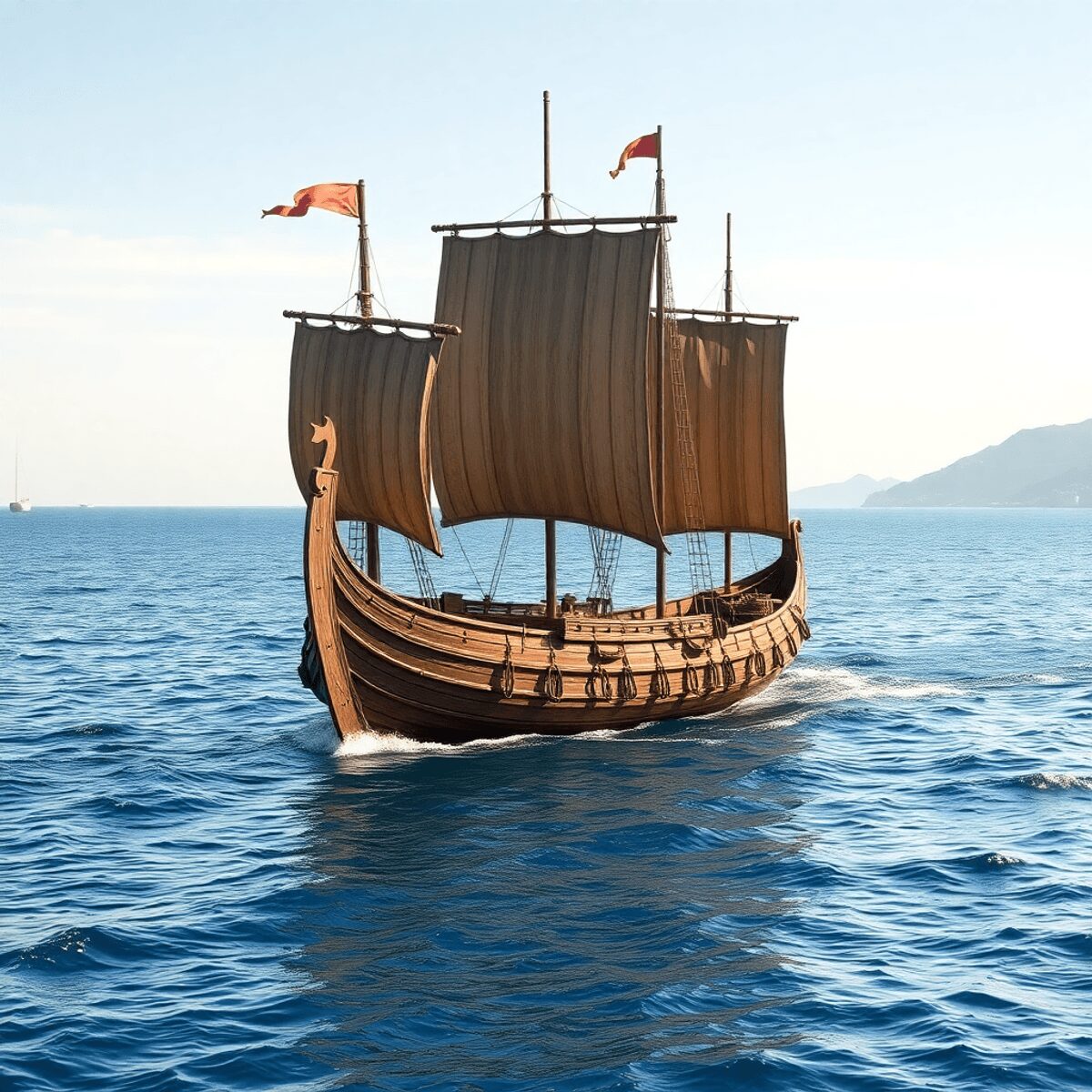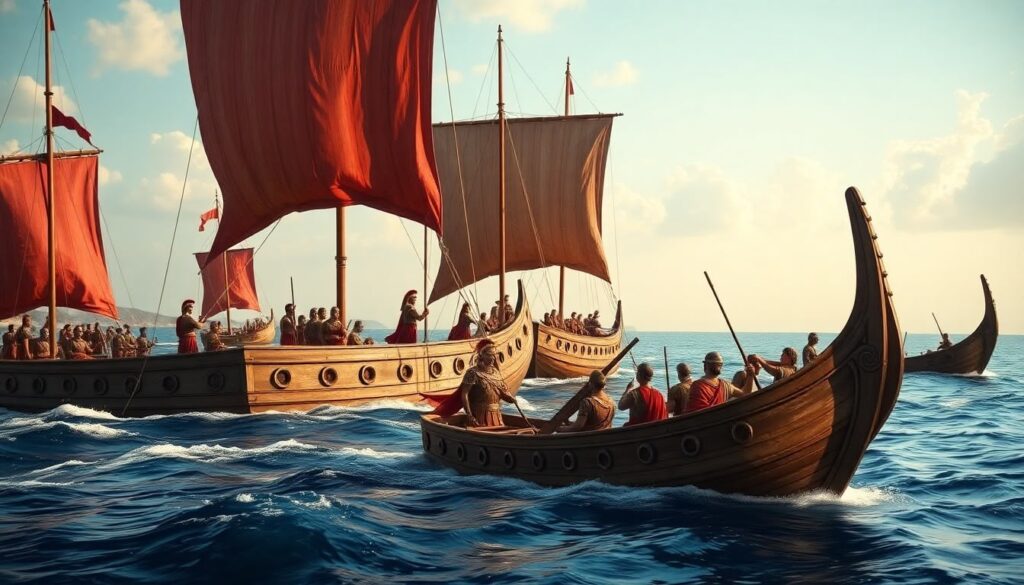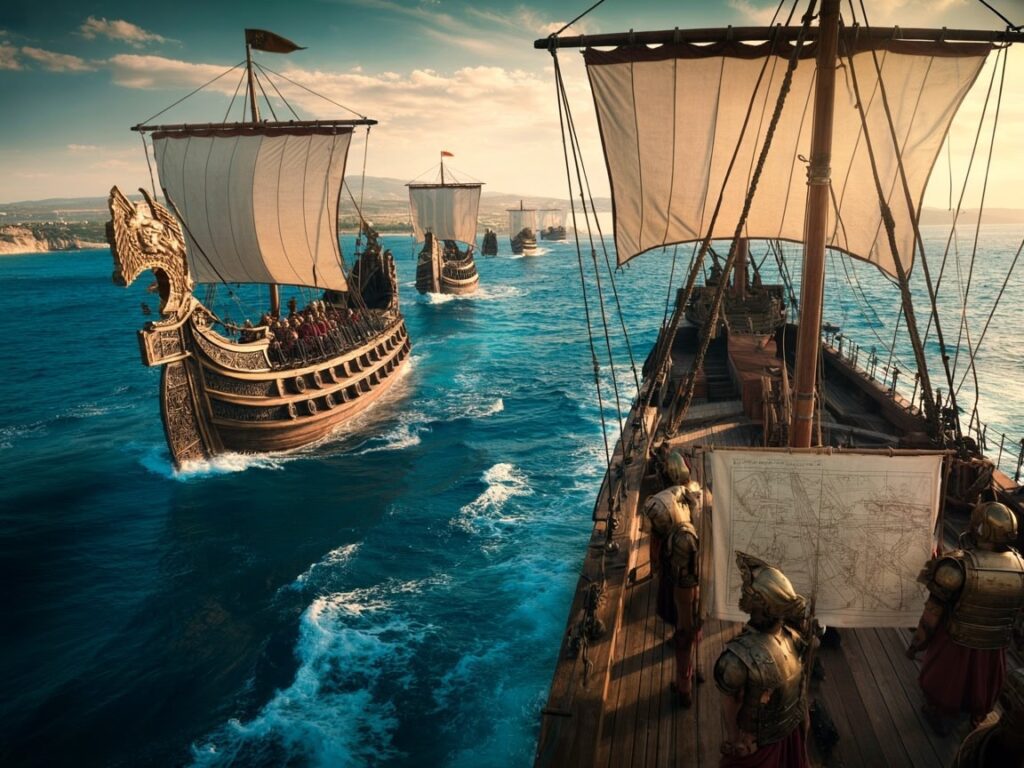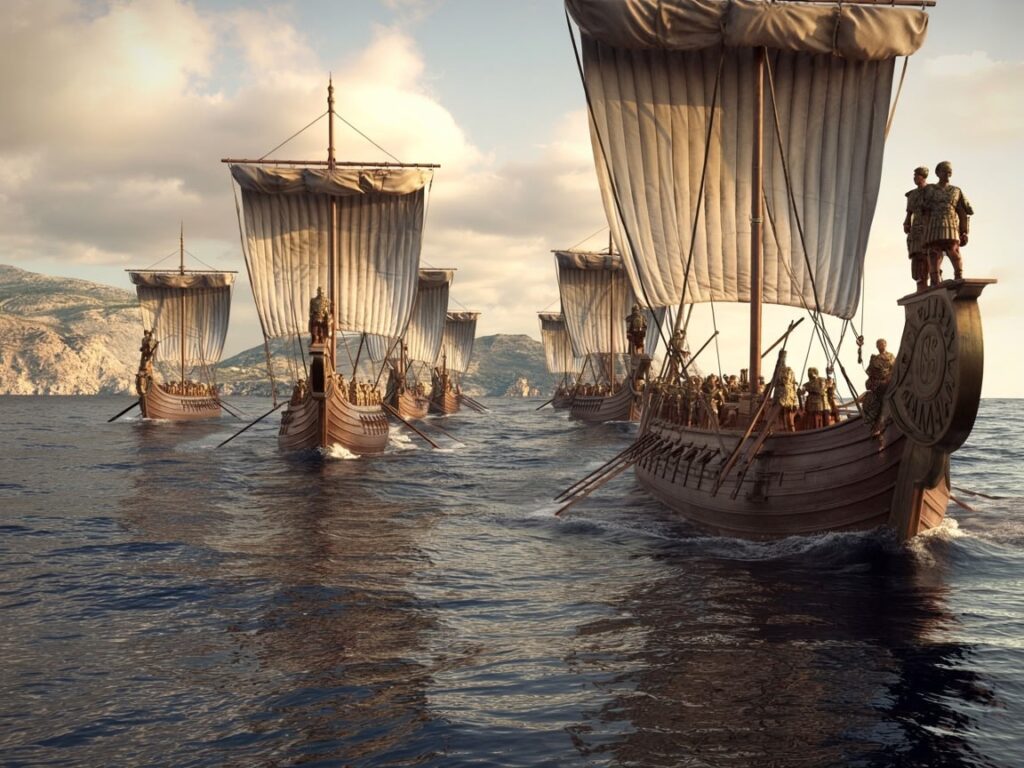Roman seafaring technology played a crucial role in establishing the dominance of the Roman Empire in maritime activities. The advancements in ship construction, navigation techniques, and naval strategies propelled Rome to establish unparalleled control over the seas. This ancient maritime power not only facilitated trade and communication but also enabled military conquests that expanded the empire’s influence across distant shores.
Understanding the technology behind Roman seafaring is crucial to appreciating the historical significance of their nautical achievements and the lasting impact they had on maritime history.
Evolution of Roman Seafaring Technology
Influence of Earlier Civilizations
Roman seafaring technology was significantly influenced by earlier civilizations such as the Carthaginians, Greeks, and Egyptians. Learning from these predecessors, the Romans adopted and adapted shipbuilding techniques to suit their expanding maritime needs.
Advancements in Ship Construction
One notable evolution in Roman ship construction was the transition from using sewn planks to implementing the mortise-and-tenon method. This advancement allowed for more secure joints between wooden components, enhancing the overall durability and structural integrity of their vessels.
Moreover, Roman engineers made notable advancements in ship construction techniques. They developed innovative methods for shaping hulls, constructing frames, and utilizing materials like timber effectively. These improvements not only increased the efficiency of building ships but also contributed to the overall seaworthiness and performance of Roman naval vessels.
The evolution of Roman seafaring technology showcases a progressive approach towards enhancing maritime capabilities and maintaining dominance in naval affairs within the Mediterranean region.
Political Transformation in Rome
This period also marked a significant transformation in the political landscape of Rome. The transition from monarchy to a republican system around 509 BCE had profound implications on governance and its enduring impact on modern political structures.
Such changes were mirrored in various aspects of Roman society, including the legal system which is still relevant today as seen in Roman Law: The Foundation of Modern Legal Systems.
Rise of Gladiators
Additionally, this era was characterized by unique social phenomena such as the rise of gladiators who were both celebrated and marginalized figures in Roman entertainment. This duality is explored in-depth in discussions surrounding the Gladiators: Heroes or Victims of Roman Entertainment.

Design and Features of Roman Naval Vessels
Warships
Roman warships were designed to be the best on the water, with a focus on being fast, maneuverable, and powerful. One type of ship that stood out in the Roman fleet was the quinquereme. It had multiple rows of oars and a strong build, representing the strength of Roman naval power.
Key Elements of Warship Design
Here are some important features that were considered when designing these warships:
- Bronze Rams: The front part (prow) of Roman warships had a bronze ram (rostrum) attached to it. This weapon was specifically made to pierce or crush enemy ships below the waterline, making naval battles more intense and forcing ships to get close to each other.
- Propulsion Methods: Quinqueremes used both sails and rows of oarsmen arranged in tiers for movement. The oars allowed for precise control and quick acceleration during battle maneuvers, while sails helped conserve energy during long journeys.
- Speed and Underwater Ratio: Roman shipbuilders designed the hull shape to optimize speed. The length-to-beam ratio underwater usually ranged from 6:1 to 7:1, resulting in sleek vessels capable of reaching speeds up to 7 knots under ideal conditions. This ratio improved stability without compromising agility.
- Boarding Tactics with the Corvus Device: One innovative strategy employed by Rome involved using a device called corvus, which was a boarding bridge with a spike that could be dropped onto an enemy ship’s deck. This tactic turned naval battles into infantry fights at sea by allowing Roman soldiers to efficiently board enemy vessels using techniques outlined in this detailed article about the Roman corvus boarding ramp.
The combination of these design features made Roman warships not only fast and sturdy but also deadly platforms for tactical warfare. Speed enabled quick strikes and retreats; rams could disable opponents before they even closed in; boarding devices allowed Romans to leverage their land-based combat skills in maritime settings.
Roman seafaring technology reached heights that supported extensive military campaigns and secured critical sea lanes. Their naval vessels embodied a synthesis of engineering precision, tactical innovation, and practical design tailored for both open-water combat and coastal operations. This mastery contributed significantly to Rome’s ability to project power across the Mediterranean basin.
Merchant Ships
Roman merchant ships played a vital role in their maritime capabilities as well. These vessels prioritized efficient cargo transport rather than battlefield agility.
Importance of Merchant Vessels
Merchant ships were essential in supporting the luxurious lifestyles of the patricians, who were the wealthy elite in ancient Rome.
While warships focused on military prowess, it was through these merchant vessels that goods could be transported across vast distances, connecting different regions economically and culturally.
The design choices made for these merchant ships would have been influenced by factors such as:
- Cargo capacity
- Stability during loading/unloading operations
- Speed for timely deliveries
Merchant Ships
Roman merchant ships played a crucial role in sustaining the empire’s vast economy by transporting goods, grain, and materials across the Mediterranean and beyond. Unlike warships such as quinqueremes that focused on speed, combat tactics, and maneuverability using bronze rams and a combination of sails and oarsmen for propulsion, merchant vessels prioritized cargo capacity and stability.
Key characteristics of Roman merchant ships included:
- V-shaped hulls: Designed to cut through water efficiently while providing enhanced stability. This hull shape allowed these ships to carry heavy loads without sacrificing seaworthiness.
- Ballast: Heavy materials placed in the lower parts of the ship ensured balance and prevented capsizing during rough seas or when heavily loaded.
- Double planking: Strengthened the hull structure to withstand long voyages and protect valuable cargo.
Navigation techniques for merchant ships relied on practical knowledge rather than compasses. Mariners used:
- Landmarks along coastlines,
- Celestial navigation by observing the sun at noon or the pole star at night,
- Sailing directions documented in periploi (ancient written guides),
- Wind patterns and sea swells.
These methods combined with experienced crews enabled reliable passage across complex shipping routes connecting key ports like Ostia. The focus on cargo transportation shaped merchant ship design distinctly from warships built for combat efficiency and speed, reflecting different priorities within Roman seafaring technology.
The engineering prowess displayed in the design and construction of these merchant ships is a testament to Roman engineering feats that changed the world. Their techniques not only facilitated effective governance and cultural exchange across far-flung regions but also laid a foundation for contemporary infrastructure systems.

Roman Shipping Routes and Trade Network
The Romans had a powerful navy that controlled the Mediterranean Sea, allowing them to establish a vast network of trade routes. These routes connected different regions of the empire, facilitating the movement of goods, people, and military forces.
Key Components of Roman Maritime Dominance
- Trade Routes: The Romans developed an extensive system of trade routes that spanned across the Mediterranean. These routes connected major cities and provinces, enabling the exchange of goods such as grain, olive oil, wine, and textiles.
- Ports: Strategic ports played a crucial role in managing trade activities. Ostia, located near Rome, was the primary port handling imports into the capital. Puteoli (modern Pozzuoli) served as a key hub for trade with the Western Mediterranean, while Alexandria was vital for connections with the East.
- Navy: The Roman navy actively patrolled important sea lanes and coastal areas to protect merchant vessels from piracy. By suppressing pirate threats through naval operations, Rome ensured the safety of its maritime trade and maintained control over economic interests.
The Importance of Maritime Connectivity
The ability to move goods efficiently by sea greatly benefited Rome’s economy. It allowed for:
- Resource Distribution: Essential resources like grain from Egypt or timber from Gaul could be transported quickly to meet demand in urban centers or military outposts.
- Cultural Exchange: Trade brought diverse cultures into contact with one another, leading to an exchange of ideas, art forms, and technologies throughout the empire.
- Military Logistics: Naval power enabled rapid deployment of troops and supplies during military campaigns across different regions.
To understand more about how these trade routes shaped the economy and society of Ancient Rome, you can explore resources like Men of Pompeii, which offers extensive information about this fascinating period in history.
Adaptation and Innovation in Roman Seafaring Technology
The Romans’ adaptation to political changes and economic fluctuations within the empire played a crucial role in shaping their maritime technology. Here are some key points to consider:
1. Political Changes
Expansion
As the Roman Empire expanded, the need for more advanced ships grew. The Romans adapted their ship designs to accommodate longer voyages and varied sea conditions encountered in new territories.
Military Strategy
The evolving political landscape influenced the innovation of warship designs, focusing on enhanced combat capabilities to maintain control over conquered regions. This was largely facilitated by the Roman Army, a symbol of military power that played a crucial role in the growth and upkeep of the Roman Empire.
2. Innovation in Ship Design
Size and Functionality
Innovations in shipbuilding techniques led to larger and more specialized vessels capable of carrying heavier cargo or supporting military campaigns. This shift towards larger vessels can be seen as an early step towards the emergence of mechanized transportation systems, which would later revolutionize transport globally.
Material Improvements
Experimentation with different types of wood, such as cedar and pine, resulted in sturdier ships that could withstand long journeys and harsh seas.
3. Navigation Techniques
Advancements in Cartography
The Romans refined their mapping skills, creating more accurate charts for safer navigation along trade routes. This was similar to their development of Roman roads, which were significant in maintaining and expanding the empire.
Celestial Navigation
Despite not using compasses, Roman sailors relied on celestial bodies like stars and the sun to guide their way, showcasing their expertise in astral navigation techniques.
The continuous adaptation to external factors and a commitment to technological innovation solidified Rome’s position as a dominant force in ancient maritime power. This adaptability is also reflected in the lives of plebeians, who represented the majority of Roman society and significantly influenced the development of political and economic structures. Additionally, the cultural impact of Rome extends beyond its borders, as seen in the influence of Roman mythology on modern culture.

The Enduring Legacy of Roman Seafaring Technology
The legacy of Roman seafaring technology continues to resonate through maritime history, leaving an indelible mark on trade and military movements in the Mediterranean region:
1. Lasting Impact
The advancements made by the Romans in ship design, navigation methods, and naval strategies have had a lasting impact on maritime practices that followed. Their innovations set a precedent for future civilizations seeking dominance at sea. This is just one aspect of the broader legacy of Ancient Rome, which remains a cornerstone of Western civilization.
2. Influence on Mediterranean Trade
Roman seafaring technology played a pivotal role in shaping the trade routes and economic prosperity of the Mediterranean region. The efficient movement of goods and people facilitated by Roman ships laid the foundation for extensive trade networks that connected diverse cultures. These trade routes were not only crucial for economic prosperity but also for the dissemination of art and culture across the Mediterranean.
3. Military Movements Throughout History
The strategic use of naval power by the Romans influenced military strategies in subsequent eras. The lessons learned from Roman maritime prowess were studied and emulated by later civilizations seeking to exert control over key waterways for both trade and defense purposes. A notable example of this is seen in the military achievements of figures like Scipio Africanus, whose strategies during the Second Punic War changed the course of history and established Rome’s dominance over Carthage.
Moreover, it’s important to note that while Roman women had certain rights, their legal status was often influenced by their relationships with men, as discussed in detail in our article about the legal status of Roman women. Additionally, the governance structure established during this period, including significant milestones like the Twelve Tables, has shaped legal systems even to this day.

FAQs (Frequently Asked Questions)
What was the significance of Roman seafaring technology in ancient maritime power?
Roman seafaring technology was crucial in establishing and maintaining ancient maritime power by enabling the Romans to dominate maritime activities, protect trade routes, and expand their influence across the Mediterranean.
How did Roman shipbuilding techniques evolve over time?
Roman shipbuilding evolved from earlier civilizations’ methods, transitioning from sewn planks to the more advanced mortise-and-tenon construction technique, leading to stronger and more durable ships suited for both war and commerce.
What were the key design features of Roman naval warships like quinqueremes?
Roman warships, such as quinqueremes, featured bronze rams for striking enemy vessels, combined propulsion through sails and oarsmen for speed and maneuverability, and utilized boarding tactics with devices like the corvus to enhance combat effectiveness.
How did Roman merchant ships differ in design and function from warships?
Roman merchant ships were designed with V-shaped hulls and ballast for stability during cargo transportation. Unlike warships, they emphasized capacity and navigation efficiency without compasses to support extensive trade networks across the empire.
What role did Roman shipping routes and ports play in the empire’s trade network?
Roman shipping routes connected key ports such as Ostia near Rome, facilitating extensive trade within the empire. The navy protected these routes from piracy, ensuring safe and efficient movement of goods across the Mediterranean.
How did political changes influence innovation in Roman seafaring technology?
Political and economic shifts within the Roman Empire drove adaptations in ship design and navigation techniques, fostering continuous innovation that enhanced maritime capabilities and sustained Rome’s dominance in Mediterranean trade and military movements.

